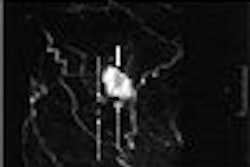Close or positive margins in breast-conserving treatment are indicative of a greater risk for residual disease upon re-excision, but cannot be used to predict the extent of disease or whether radiotherapy will result in disease control, cancer specialists report in a new study.
The risk of ipsilateral breast tumor recurrence after breast conservation and radiation has been shown to increase in the presence of positive margins, explained lead author Dr. Derek Chism from the North Shore Medical Center in Peabody, MA. Chism's co-authors are from the departments of radiology oncology and biostatistics at Fox Chase Cancer Center in Philadelphia.
Margin re-excision is performed for two main reasons: fewer local relapses and additional diagnostic information, the group stated in the International Journal of Radiology Oncology, Biology, Physics (August 1, 2006, Vol. 65:5, pp. 1416-1421).
In this study, the authors investigated whether re-excision offered a therapeutic or diagnostic benefit as well as the pathologic features that can better delineate which patients should undergo re-excision.
All patients with stage I or II invasive breast cancer who were treated at Fox Chase over a 27-year period were included. Of these 1,044 patients, 37% received no adjuvant chemotherapy or tamoxifen. The women were divided into three groups: group 1 consisted of 199 patients accepted for breast-conservation therapy and treated with radiation therapy, without undergoing re-excision.
Women in group 2 underwent re-excision but had no residual cancer. Group 3 was made up of patients in whom re-excision found either residual invasive cancer or ductal carcinoma in situ (DCIS). A close margin was defined as DCIS or invasive cancer that was 2 mm or less from the inked surgical margin. Groups 2 and 3 consisted of 845 women who underwent at least one re-excision before radiation treatment.
According to the results, women in group 1 who were accepted for radiation without additional therapy were more likely to be older than 70, had a closer positive margin (73% versus 38% of groups 2 and 3), had stage T2 tumor size, and had no extensive in situ component.
The 10-year actuarial local control rate for women who did not have re-excision was 95% versus 94% for those who did have re-excision. Of the latter group, 65% had no residual invasive or in situ carcinoma while 35% did.
The 10-year freedom from distant metastasis rate for group 1 was 88%. For group 2, it was 90% and for group 3, it was 81%. The 10-year overall survival rate for group 1 was 70%, 79% for group 2, and 73% for group 3.
"Our findings suggest that re-excision produced additional diagnostic information, distinguishing between a subset of women at extremely low risk of developing cancer (group 2, 5%) and a subset at a slightly greater risk of recurrence (group 3, 9%)," the authors wrote.
The researchers also found that group 2 had greater local control than group 3, which implies that the volume of residual disease in the breast affects the probability of local control with radiotherapy. They stressed that it is this residual disease volume, and not the likelihood of its presence, that is important for determining the effectiveness of radiation treatment.
Finally, they identified four factors for predicting the absence of residual disease on re-excision: close margins, stage T1 size, negative nodes, and negative extensive intraductal component.
By Shalmali Pal
AuntMinnie.com staff writer
August 30, 2006
Related Reading
Preop FDG-PET spots axillary involvement in breast cancer, may obviate biopsy, August 21, 2006
Breast cancer-involved sentinel nodes often contain micrometastases, August 15, 2006
Radiotherapy can benefit elderly women with early breast cancers, May 17, 2006
Copyright © 2006 AuntMinnie.com



















